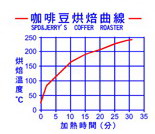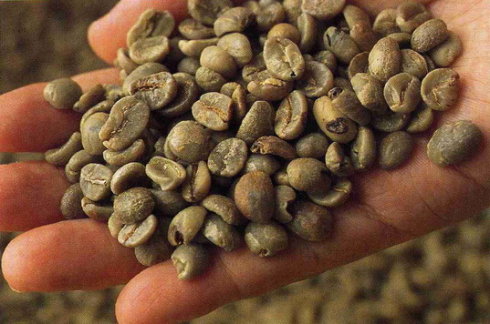Roasting techniques for the treatment of raw coffee beans: coffee bean roasting theory (3) detailed introduction
In addition to the degree of baking is divided into factions, even the roaster also has a family view. At present, there are two major professional roasters, one is the traditional rolling furnace (Drum Roaster), and the other is the newly rising hot gas furnace (Air Roaster). The former uses gas to heat the beans across the bottom of the furnace, and the metal blades in the furnace keep stirring the beans, while the latter uses high-temperature hot air to bake the beans. Because of the strong air flow, the beans in the furnace keep flying, so there is no need for leaves to stir the beans. It takes a long time to bake beans in converter, which is generally called slow stew pie, while the speed of baking beans in hot gas stove is faster, which belongs to fast fried pie.
Hot gas furnace (Air Roaster) rolling furnace (Drum Roaster)
The industry is red-faced over the merits of these two kinds of roasters, and it is also described as a "war between slow stew pie and fast stir-fry pie." slow stew pie prefers the traditional rolling furnace, believing that it should be roasted at a warm temperature at first, and then slowly increase the heat after an explosion, so that the water in the beans can be prevented from evaporating too fast, and the damage to the cell tissue can be minimized. Only by heating step by step can the flavor of coffee beans be fully developed. Those who advocate slow stewing are mostly famous glutton coffee, such as Bitz, Vivac, Allegro and coffee bean and machine companies. Their baking time is about eleven to 25 minutes. Interestingly, the scale of slow speculators is relatively small, emphasizing a small amount of baking, disdain to win by quantity, careless speculation.
Basic Construction principle of Rolling Furnace (Drum Roaster)
Fast fried beans have a strong sour taste, while slow fried beans prefer to use a hot stove. They think that strong hot air flow, better heat conduction and average heating of beans can achieve the desired baking degree in the shortest time, thus reducing the disappearance of coffee oil and damage to cell tissue. The baking time is mostly within three to fifteen minutes. Since quick frying saves time and less weight loss of coffee beans, it can save money, so the heat stove operators are mostly large baking companies that win by quantity, and most of the coffee from Burger King and McDonald's in the United States is made by heat stove operators. Generally speaking, the sour taste of fast fried beans is more obvious, but also more layered, but slow fried beans suppress the sour taste, drinking is relatively low and sweet.
Basic construction principle of hot gas furnace (Air Roaster)
The relationship between fast and slow stir-frying and chlorogenic acid plants contain bitter and strong chlorogenic acid "Chlorogenic acids" to resist insect pests or bacteria. Coffee raw beans also contain a large amount of chlorogenic acid, which has something to do with the green-blue color of raw beans, and the content of chlorogenic acid is also proportional to caffeine. Low-altitude robusta raw beans have more caffeine than high-altitude Arabica beans, so the content of chlorogenic acid is also higher. Studies have shown that Robusta contains 10% chlorogenic acid, while Arabica has only about 6%. No wonder Robusta has a bitter taste.
Chlorogenic acid is a kind of organic acid with the highest content in raw beans, and it is also the original culprit that causes the acidity and bitterness of coffee. Fortunately, chlorogenic acid will be destroyed in the baking process. More importantly, the degree of chlorogenic acid disintegration is inversely proportional to the baking speed, that is to say, the faster the baking, the more chlorogenic acid remains, the slower the roasting, the less the residue. This is enough to explain why quick fried beans drink more tart while slow fried beans have a smoother flavor. Therefore, espresso beans are more suitable for slow frying. If you stir-fry espresso in a hot stove at 300 to 400 degrees Celsius, a second explosion may occur in less than three minutes. However, too much chlorogenic acid will make espresso sour too sour.
The relationship between baking and high-quality acids in addition to inferior chlorogenic acid, raw beans also contain a lot of high-quality acids, such as citric acid, malic acid, acetic acid, phosphoric acid and quinic acid. In addition, other organic acids will be born with the disintegration of carbohydrates in the baking process. At present, as many as 34 kinds of organic acids have been determined, of which 15 are volatile. In principle, the concentration of high-quality citric acid, malic acid, phosphoric acid and acetic acid is the highest in moderate baking and decreases with heavy baking. Organic acids affect the flavor of coffee to a great extent. Interestingly, the pleasant and lively acid of light roasted coffee is the overall expression of more than 30 kinds of organic acids, any one of which is particularly prominent and will have a bad taste. Coffee roasting is a great learning. the age, density, hardness and moisture content of raw beans should be considered. even the relative humidity on the baking day, cloudy, sunny, rainy, temperature and wind direction changes can not be ignored. So the baker is not only an artist but also half a scientist!
Source:
The blog of the coffee wizard
Important Notice :
前街咖啡 FrontStreet Coffee has moved to new addredd:
FrontStreet Coffee Address: 315,Donghua East Road,GuangZhou
Tel:020 38364473
- Prev

Roasting techniques of Coffee Bean treatment: coffee Bean Baking Theory (1) detailed introduction
(reprint) grab a handful of coffee and smell raw beans, there is always a pungent smell, which is very different from the charming smell of coffee in your impression. However, after roasting "fragrance" correctly, raw beans will emit the strongest aroma in the world. The small high-altitude Arabica coffee raw beans are like a warehouse full of chemicals. At present, scientists have identified more than 2,000 known ingredients.
- Next

Introduction to the main points of knowledge about the treatment of raw coffee beans: the importance of hand selection how to select beans by hand
Previously discussed a good cup of coffee, that is, the selection of flawless coffee beans, after proper roasting, fresh grinding, brewing, the correct extraction of the taste of coffee standards and practical steps. (please refer to the previous post: what is a good cup of coffee and how to get a good cup of coffee?) The standard procedure is as follows: 1. Master raw beans 2. Raw bean hand chooses 3. Fresh baking 4.
Related
- What is the meaning of lactic acid fermentation with coffee bean treatment?
- How to judge the state of foam by sound?
- How does the latte pull out the unicorn pattern? Come to get for a little trick to improve the flower pull!
- Will flower pulling affect the taste of the latte?
- Do you know the history of coffee?
- The difference between honey treatment and sun washing what is raisin honey treatment?
- What kind of milk can a novice use to make coffee foam to keep the foam longer? The correct method and skills of milking tutorial sharing
- Why do washed coffee beans taste sour? Flavor characteristics of washed Coffee
- Introduction to the skill of how to practice the size and height of water injection around the circle of hand-brewed coffee
- How do beginners practice coffee flower drawing from scratch?

